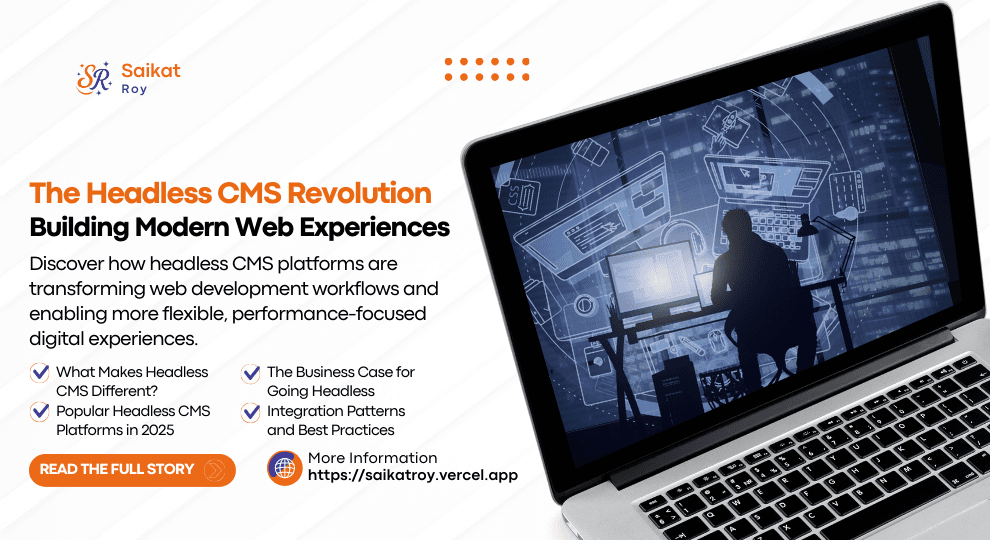The Headless CMS Revolution: Building Modern Web Experiences
In today's digital landscape, delivering fast, secure, and engaging web experiences is more crucial than ever. Traditional content management systems that tightly couple the content layer with the presentation layer are increasingly giving way to headless CMS architectures. This paradigm shift is redefining how developers and content teams collaborate to build modern digital experiences.
What Makes Headless CMS Different?
Unlike traditional CMS platforms where content management and frontend presentation are intertwined, headless CMS solutions focus exclusively on content management and delivery through APIs:
API-First Architecture: Content is delivered via RESTful or GraphQL APIs, allowing developers to build frontend's with any technology stack.
Frontend Agnostic: The same content can be used across websites, mobile apps, IoT devices, digital displays, and emerging platforms.
Separation of Concerns: Content creators work independently of developers, with each team focusing on their core responsibilities.
Focused User Interfaces: Admin interfaces designed specifically for content operations rather than trying to accommodate development tools.
The Business Case for Going Headless
Organizations are increasingly adopting headless architectures for compelling reasons:
Omnichannel Content Delivery: Create once, publish anywhere - from websites to mobile apps, voice assistants, and digital kiosks.
Future-Proofing: As new consumer platforms emerge, your content can be adapted without rebuilding your entire content infrastructure.
Performance Optimization: Static site generation and CDN delivery become straightforward with decoupled architectures.
Developer Experience: Freedom to use modern development tools and frameworks leads to better talent attraction and retention.
Scalability: Content API layers can be scaled independently from presentation layers based on traffic patterns.
Popular Headless CMS Platforms in 2025
The headless CMS market has matured significantly with several standout platforms:
Enterprise Solutions
Contentful: The market leader has expanded its offering with AI-powered content operations and advanced localization.
Sanity: Known for its structured content approach and real-time collaboration features.
Strapi: The leading open-source solution has gained enterprise features while maintaining developer flexibility.
Specialized Platforms
Commerce-focused CMS: Platforms like CommerceLayer and Saleor headless have integrated content and commerce capabilities.
Digital Asset Management: Specialized solutions for media-heavy organizations with advanced AI tagging and transformation.
Community-focused CMS: Platforms optimized for user-generated content and community engagement.
Integration Patterns and Best Practices
Successfully implementing a headless CMS requires thoughtful architecture decisions:
Content Modeling Strategies: Structured content approaches that balance flexibility and consistency.
Preview Environments: Solutions for content teams to visualize changes before publishing.
Authentication and Permissions: Securing content APIs while maintaining performance.
Edge Rendering: Pre-rendering strategies at the CDN edge for optimal performance.
Reusable Component Libraries: Building systems that empower non-technical users to assemble pages within design constraints.
The Role of AI in Modern CMS Workflows
Artificial intelligence is transforming how content is created, managed, and delivered:
Automated Content Generation: AI assistants that help draft content, suggest improvements, and generate variations.
Content Intelligence: Systems that analyze performance and suggest optimizations.
Smart Asset Management: Automated tagging, cropping, and optimization of media assets.
Personalization Engines: Content recommendation systems based on user behavior and contextual signals.
Measuring Success: Beyond Page Views
With headless architectures, organizations are rethinking how they measure content effectiveness:
Component-Level Analytics: Understanding performance of individual content components rather than just pages.
Cross-Platform Engagement: Tracking how the same content performs across different platforms and presentations.
Content Velocity Metrics: Measuring efficiency of content operations from creation to publication.
Performance Budgets: Ensuring content delivery meets performance thresholds across devices and networks.
Challenges to Consider
Despite the benefits, headless CMS adoption comes with challenges:
Initial Complexity: The separation of concerns can introduce complexity in the initial setup and integration.
Preview Functionality: Creating seamless preview experiences for content editors requires additional development.
Managing Multiple Systems: Integration points between CMS, asset management, and delivery systems need careful architecture.
Team Skills Adaptation: Content teams need to adapt to thinking about structured content rather than page layouts.
Looking Forward: The Future of Content Management
Where is content management headed next?
AI-First Content Operations: AI moving from assistant to collaborator in the content creation process.
Composable Enterprise: Organizations assembling best-of-breed solutions rather than all-in-one platforms.
Content Mesh: The emergence of unified content layers that aggregate multiple specialized content sources.
Ambient Content Delivery: Content automatically adapting to context and environment without explicit design for each channel.
Have you implemented a headless CMS in your projects? What challenges and benefits have you experienced? Share your thoughts in the comments below!
